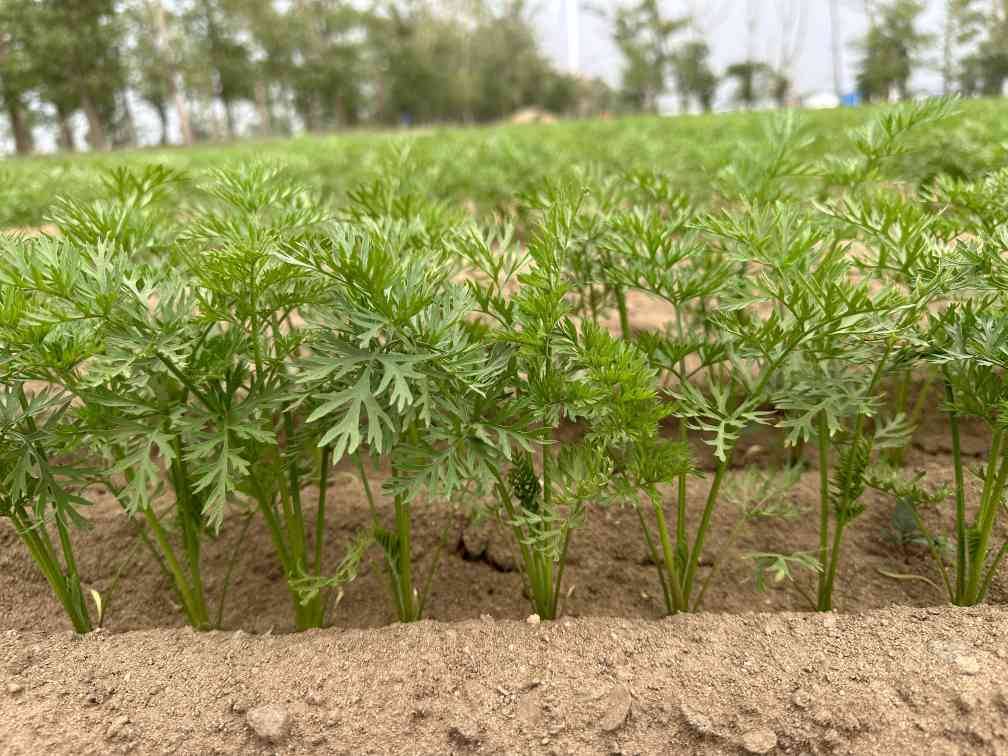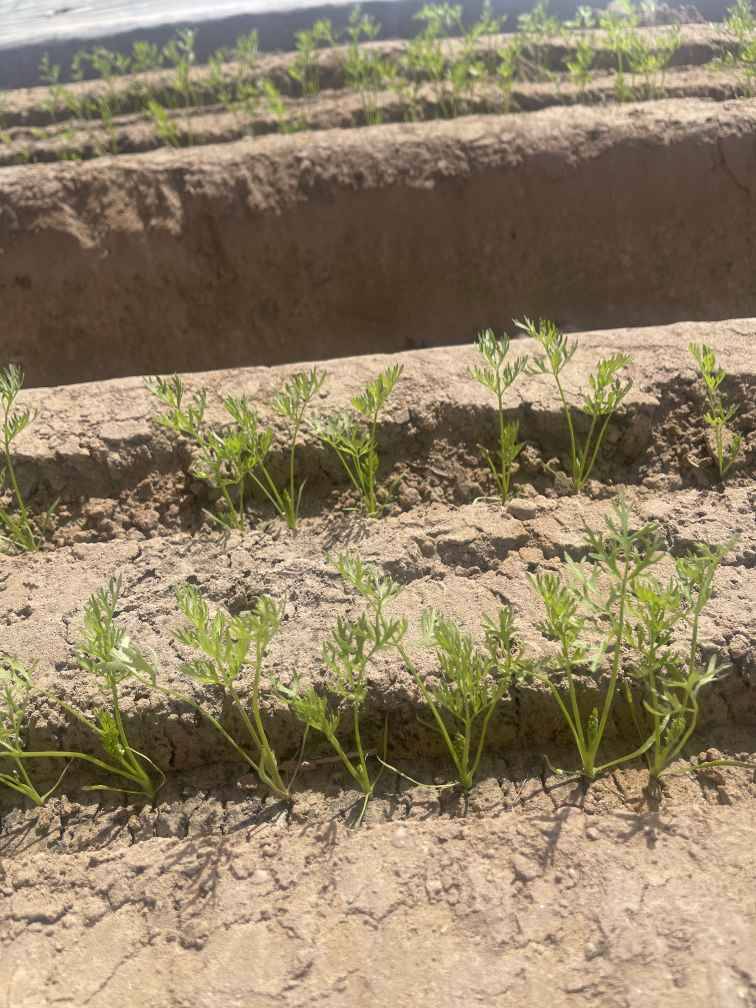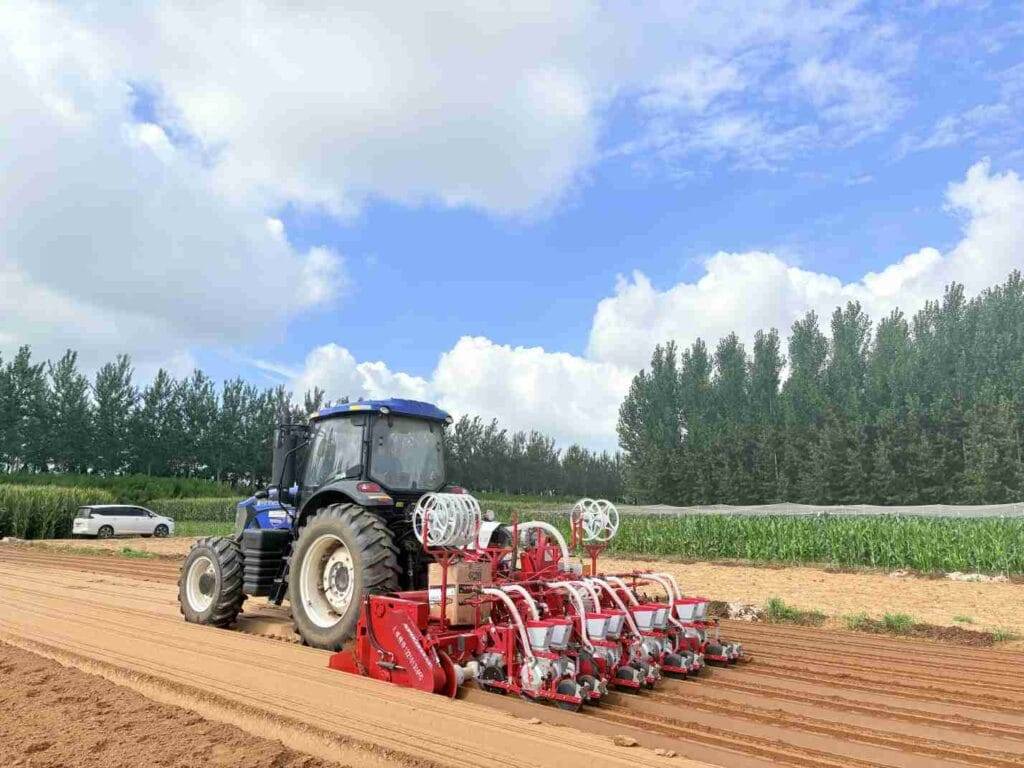Carrots are common root vegetables in people’s daily lives, widely planted due to their rich nutrition, storage tolerance, and high market demand. In actual production, the emergence rate and uniformity of carrots often directly determine yield and marketability. In the sowing process, how to ensure even sowing depth, reasonable plant spacing, and low seed damage rate is the most concerned issue for growers. The air suction carrot seeder, with its advantages of “negative pressure suction and precise planting”, has become an ideal equipment in modern carrot production. This article will provide a detailed introduction to the entire process of sowing carrot seeds from the perspective of an air suction carrot seeder.

1、 Basic requirements for sowing carrot seeds
1. Growth habits and sowing characteristics of carrots
Carrots belong to the Umbelliferae family, a biennial herbaceous plant that prefers cold and cool climates, with a suitable temperature of 1520 ℃. Its root system is well-developed and requires high soil looseness. Carrot seeds are small and light, with a thousand grain weight of only 1.01.2 grams, irregular shape, strong water absorption but slow germination. When sowing, if the depth is too deep or too shallow, it may lead to difficulty or unevenness in seedling emergence.
Therefore, carrot sowing must achieve:
Reasonable row spacing and plant spacing (generally 20-30 centimeters for row spacing and 36 centimeters for plant spacing);
Suitable broadcasting depth (usually 1.0-1.5 centimeters);
• Seed evenly to avoid missed or replayed broadcasts;
Cover the soil finely, which is conducive to moisture preservation and seedling emergence.
2. Requirements for sowing machinery based on the characteristics of carrot seeds
Due to the small and irregular size of carrot seeds, traditional manual sowing or seeding is difficult to ensure uniformity, which not only wastes seeds but also affects yield. Mechanical seeding must meet the following requirements:
• Able to accurately adsorb and distribute seeds;
The depth of the next seed should be consistent, with an error not exceeding 0.5 centimeters;
High homework efficiency, suitable for large-scale planting;
• Do not damage the seeds and improve germination rate.
The air suction seeder precisely meets these requirements.

2、 Structure and principle of air suction carrot seeder
1. Basic structure of air suction seeder
An air suction seeder usually consists of a frame, a vacuum pump (fan), a seed suction tray, a seed box, a transmission system, a trencher, a soil cover, and a compaction wheel. The core component is the gas suction and seeding device, which uses negative pressure to adsorb seeds onto the suction hole and rotates with the suction cup to the seeding position. After losing the vacuum pressure, the seeds fall into the groove.
2. Working principle of negative pressure seed suction
The working process of the suction seeding device is as follows:
The vacuum pump generates negative pressure;
The seeds are adsorbed into the tiny suction holes on the turntable;
The turntable rotates to the designated position, the vacuum disappears, and the seeds naturally fall;
The seeds enter the sowing ditch through the seeding tube, and then are covered with soil and compacted.
This method can achieve single or few seed sowing, greatly improving the uniformity of sowing.
3. Advantages compared to other sowing methods
Compared to manual sowing: efficiency is increased by 5-10 times, and seed usage is saved by more than 30%.
Compared to mechanical sowing: avoid uneven density and improve the uniformity of seedling emergence.
Compared to mechanical wheel seeding, it has better adaptability to small and irregular seeds.
Therefore, the air suction seeder is particularly suitable for sowing small seeds such as carrots.
3、 Preparation before sowing
1. Soil leveling and moisture preparation
Carrot roots are sensitive to soil looseness. Before sowing, deep plowing (more than 25 centimeters) should be carried out, with a fine rake and leveling to avoid excessive soil blocks affecting the rooting of young roots. At the same time, it is necessary to maintain appropriate soil moisture, that is, “seeing dryness and wetness”, holding it in hand and dispersing it when it falls to the ground.
2. Seed selection and pesticide treatment
Carrot seeds germinate slowly. To improve germination rate, they should be carefully selected and treated in advance
• Selection: Remove damaged, undersized, or malformed seeds;
• Seed soaking and germination promotion: Soak in warm water for 12 hours, then sand for 1-2 days;
• Chemical treatment: Mix seeds with fungicides to prevent and control seedling diseases.
3. Inspection and adjustment of seeder
Equipment must be checked before sowing:
Check whether the vacuum pump is normal and whether the suction hole is unobstructed;
Replace or adjust the suction tray according to the seed size;
Lubricate transmission components to ensure flexible operation;
Correction of line spacing and depth device.

4、 Operation steps of suction carrot seeder
1. Setting of broadcast depth and line spacing
Carrots are usually sown at a depth of 1.0-1.5 centimeters. If they are too deep, it will affect seedling emergence, while if they are too shallow, they are easily blown dry by the wind. The row spacing is set to 2030 centimeters, depending on the mechanical model and planting density.
2. Adjustment of suction disk and vacuum pressure
There may be slight differences in the size of carrot seeds from different batches, so it is necessary to choose a suitable suction disk aperture to ensure single particle adsorption. The vacuum pressure is generally maintained between 3.5~5.0 kPa. If it is too small, it is easy to leak seeds, and if it is too large, it is easy to adsorb multiple particles.
3. Control of Seed Quantity and Uniformity
By adjusting the speed of the turntable and the number of holes, the spacing between plants can be controlled. The spacing between carrot plants is generally 3-6 centimeters. When the seeder is operating, it should maintain a constant speed to avoid uneven spacing between plants caused by uneven speed.
4. Post broadcast soil covering and suppression
After the seeds fall into the ditch, they are lightly covered with fine soil by a soil covering device, and then lightly pressed by a compaction wheel to ensure that the seeds are in close contact with the soil and prevent soil compaction.
5、 Precautions during sowing process
1. Avoid missed broadcasts and replays
During homework, the condition of the seeder should be observed at all times. If any leakage is found, the machine should be stopped immediately to check if the suction hole is blocked; If replay is found, adjust the vacuum pressure or replace the orifice plate.
2. Ensure consistency in broadcast depth
Different plots of land may have varying degrees of soil elasticity, so it is necessary to adjust the depth of the trencher at any time to ensure that all seeds are planted at the same depth.
3. Prevent seed damage and blockage
Carrot seed shells are thin and fragile, so do not apply excessive suction pressure during operation. Meanwhile, the seed box should be kept clean and dry to prevent impurities from entering and causing blockages.
4. Parameter adjustment under different land conditions
For sandy loam soil, the sowing depth can be appropriately increased (1.5 centimeters), while for heavy soil, shallow sowing (1 centimeter) should be used. When the soil moisture is insufficient, the compaction pressure can be increased to maintain soil compactness.

6、 Key points of management after sowing
1. Water management during the seedling stage
Carrots sprout slowly (7-15 days), and the soil must be kept moist during this period. In case of drought after sowing, it is necessary to water the surface with “head covering water” appropriately to keep it moist.
2. Supplementing and interspersing between seedling stages
If individual acupoints lack seedlings, they should be promptly replanted manually. When the seedlings grow to 23 true leaves, the first thinning should be carried out, and the final plant spacing should be controlled at 36 centimeters.
3. Disease and pest control and field management
During the seedling stage, measures should be taken to prevent and control diseases such as Fusarium wilt and root maggots. Keep the fields free of weeds and avoid competing with carrots for fertilizer and water.
7、 Maintenance and upkeep of air suction carrot seeder
1. Common faults and troubleshooting of seeders
• Leakage: Check if the vacuum pressure is too low and if the suction hole is blocked;
• Replay: Adjust the size or pressure of the suction hole;
• No seeding: Check if the seeding tube is blocked.
2. Cleaning and lubrication maintenance
After each assignment, the seed box and suction hole should be cleaned to prevent residual seeds from becoming moldy. Regularly add lubricating oil to the transmission chain and bearings.
3. Tips for improving service life
When not in use for a long time, the equipment should be stored in a dry environment to avoid rusting. Vacuum pumps need to be regularly inspected for blade wear and replaced in a timely manner.
8、 Conclusion
The key to sowing carrots lies in suitable sowing depth, uniform plant spacing, and neat emergence. The air suction carrot seeder, with its advantages of precise sowing, high efficiency, and strong adaptability, can significantly improve the emergence rate and uniformity, laying a solid foundation for high carrot yield. Only by making sufficient preparations before sowing, strictly adhering to operational norms during sowing, and strengthening field management after sowing, can we truly leverage the advantages of air suction seeders and help promote the large-scale and mechanized development of the carrot industry.

